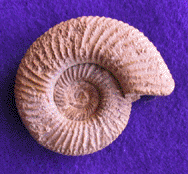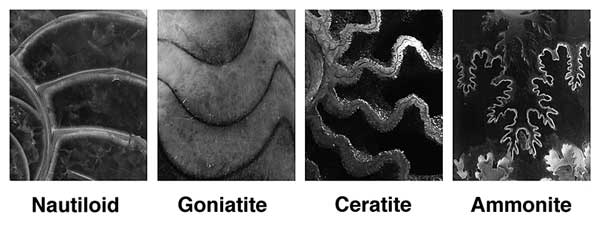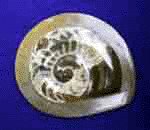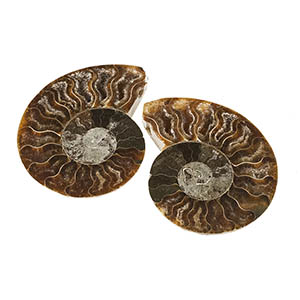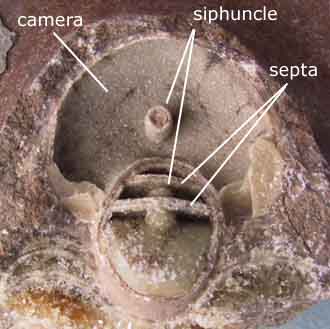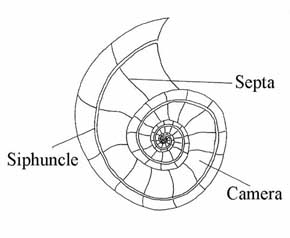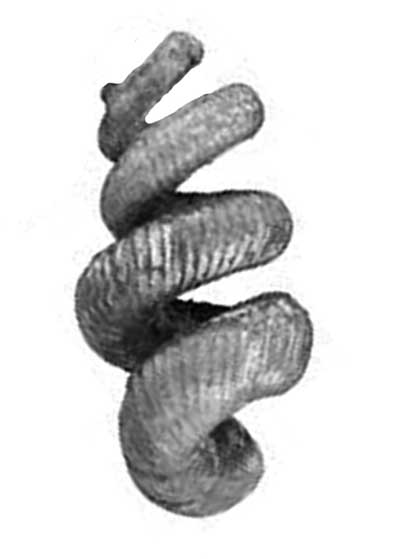Sign up for Lesson Plans, discounts & more!
The Rise And Fall of The Ammonites
Ammonites have intrigued mankind for thousands of years. This fossil has created enough interest to inspire dozens of stories, legends and myths. The name comes from its appearance: it resembles a ram’s horn. In Egyptian mythology, the God Ammon looked like a man with horns like a ram. The ancient fossil was considered Ammon’s stone, thus inheriting the name, ammonite.
Ammonites belong to the class of animals called mollusks. More specifically they are cephalopods. and first appeared in the lower Devonian Period. It is thought by some that they evolved from the older nautiloids. The cephalopods were an abundant and diverse group during the Paleozoic Era. Cephalopods are present in today's oceans as squid, octopus, cuttlefish, and nautiloids. While they are still a diverse group with about 800 species, it is estimated that there are about 17,000 extinct species.
Their hard shells were easily fossilized and so we have an abundant supply of these fossils to learn from.
The shells had many chambers divided by walls called septa. The chambers are connected by a tube called a siphuncle.
Some Details about The Shells of Ammonites
Septa
The septa are the walls that devide the chambers within the shell. Nautiloids had simple septa with a single arc. The ammonites developed septa that had intricate folds called lobes and saddles. They also developed delicate lacey patterns on the outer shell.
There are three basic patterns for ammonite septa. Nautiloids are not considered ammonites.
- irregular zigzags-this is called goniatite
- regular wavy-called ceratite
- intricate feathery or fern like patterns-ammonite
The pattern of the septa can be reflected on the outside of the shell. These are called sutures.
These patterns along with the shape of the shell and the structure of the septa are how this cephalopod is classified.
The goniatites are older ranging from the mid Devonian Period to the end of the Permian Period. They are easily recognized by the zigzag suture patterns. Goniatites are fairly common in Devonian age fossil beds in Morocco. You can see examples of these goniatites here.
While little is known for sure about the lifestyle of these extinct mollusks, we can make some educated guesses. Since all living cephalopods are predators we can assume that ammonites were as well.
The only living cephalopod with an external shell is the chambered nautilus. It can swim and control its depth. It does this by using the siphuncle.
The siphuncle is a tube that connects all the chambers in the shell with the living animal. The nautilus can add or subtract gas in these chambers to control buoyancy. It can also jet propel itself by squirting water out of a funnel like organ.
Size
Ammonites have a
wide range of size. Specimens have been found ranging from less than a
centimeter to 2 meters in diameter. Early ammonites, until the middle
Jurassic, were smaller, usually less than 9 inches or 23 centimeters.
During the upper Jurassic and lower Cretaceous larger varieties can be found. Titanites found in the south of England can be over 50 centimeters, 2 feet in diameter. Female shells of ammonites, like their modern counterpart, the nautilus, tends to be larger than the males.
Biostratigraphy
The hard shell of the ammonite was easily fossilized. This, combined with the sheer abundance of the species and its evolutionary duration through several geologic periods, make it a good index fossil.
Index Fossils
Index fossils help paleontologists and geologists to determine the age of rock layers. This is called biostratigraphy. It works like this. If you find an ammonite from a genus known to be from the Triassic Period, then the rock layer it came from must be Triassic.
To be a good index fossil:
1. It must have wide distribution.
2. There must be a lot of them.
3. It must belong to a group that evolves rapidly.
4. They must be easy to recognize.
The Ammonite Timeline
|
Paleozoic Era
|
Mesozoic Era
|
|||||||
|
Cambrian Period
|
Ordovician Period
|
Silurian Period
|
Devonian Period
|
Carboniferous Period
|
Permian Period
|
Triassic Period
|
Jurssic Period
|
Cretaceous Period
|
Extinction
The ammonites as a class survived several mass extinctions during their long tenure among the living. However the end of the Cretaceous Period was also the end for this class of cephalopods.
It is believed that a huge meteor collided with earth about 65 million years ago. This event caused a tremendous amount of dust to be thrown into the atmosphere, blocking out the sun for years. Rapid climatic changes were the result. It has been estimated that 80% of the earth’s inhabitants, including all of the dinosaurs, became extinct during this event.
Ammonite Shell Structure
Ammonite shell structure is similar to the chambered nautilus.
The chambered part of the shell is called the phragmocone, of which each chamber is called a camera. The outside of the shell is often ornamented with ridges, spines, or a pattern of lines called lirae. This ornamentation, along with shell shape, is also considered in classification.
Siphuncle and Septa
Inside the shell there is a siphuncle, a tube used for propulsion and buoyancy.The location of the siphuncle is not like the nautilus. Instead of going through the middle of the animal, it runs along the inside of the outermost spiral. The picture below shows a fossil ammonite that has been broken. This allows viewing it's inner parts. You can clearly see the siphuncle and the septa.The septa, which separate the inner chambers of the ammonite, show folds instead of smooth arcs. It is the pattern created by the folds, along with the position of the siphuncle that is the basis of classification.
Aptychi - The Front Door
Ammonites were probably able to pull their bodies inside the shell for protection. Some speices from the Mesozoic era developed hard plates called Aptychi that covered the opening.
Ammonite Classification
Ammonite Classification
Ammonites are, of course, members of the animal kingdom. Since they are without backbones, they are invertebrates. They belong to the phylum Mollusca because of their soft body and ability to create shells. Modern day varieties include snails, clams, and oysters, but the octopus and squid have a small internal shell or no shell at all. They are mollusks that belong to the class cephalopoda as does the ammonite. The tentacled head is the primary feature of the members of this class, so the modern chambered nautilus also belongs to this class. For our ancient fossil, the subclass is Ammonoidea.
These are the orders. There are also several suborders:
See the chart above showing the septa.
• Goniatitida- The goniatites ranged from the Devonian to the upper Permian Period. They are characterized by septa with round saddles and pointed lobes.
• Ceratida- This order existed from the Carboniferous Period to the Triassic Period. They are characterized by septa with round saddles and serrated lobes.
• Ammonitida- They first show up during the Permian Period and lasted through the Cretaceous Period. Their septa have folded saddles and lobes. The shells are decorated with a complex pattern of lines called lirae.
The Heteromorphs - A Breed Apart
Most ammonites have flat spiral shells, (planispiral). Some species had partial spirals, and then uncurled to a straight cone. Still others had a spiral section, then a straight section and then a curved hook so that the animal faced its spiral section. A few varieties did not follow the typical planispiral form at all. Some were helical and some curved wildly about apparently at random. All these non-planispiral forms were called heteromorphs. One unique member of this group is the baculites. They only lived during the late Cretaceous Period and had almost straight shells.
Other extinct relative of the ammonites are belemnites, orthoceras, and nautiloids.
Myths About Ammonites
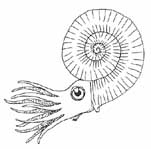
Ammonite fossils have intrigued mankind for centuries. There are myths and legends about them from cultures all around the world. Here are a few of those stories.
North America
Good Hunting
The Blackfeet Indians called ammonites buffalo stones for their resemblance to a sleeping buffalo. They were considered good fortune and used in ceremonies before a buffalo hunt. It was also good fortune to find an ammonite just before taking a journey.
Europe
Ammonites: Good for Cows!
Long ago in Germany a remedy for a cow gone dry was to put an ammonite in the milk pail.
Scotland had a variation on that theme. It was said that washing a cow with water that had an ammonite in it for a few hours would cure the cow of cramps. They were called cramp stones.
In England ammonites were called snake stones. One story has it that Saint Hilda, the Abbess at the double monastery in Whitby c. 650 A.D., wanted to build a convent there as well. Alas, the ground for the building was infested with snakes. St. Hilda, through devout prayer, caused the snakes to curl up and turn into stone.Around Whitby there is a tradition of carving heads on ammonites or snake stones. There is even an ammonite named after St. Hilda, the Hildaceras.
GreeceIn ancient Greece it was said that if you put an ammonite under your pillow it will cure insomnia and bring good dreams.
When in Rome…The Romans believed that if you put a golden ammonite (pryritized) under your pillow you would have prophetic dreams.
Ammonite fossils For Sale. Fossilicious.com has a wide selection of ammonites to add to your collection or classroom.
Free printable Ammonite Wordsearch Puzzle
Free printable Ammonite Crossword Puzzle
Check out some of the Educational Materials for sale on our sister site fossilicious.com.

interested in more? If so, you may want to check out our other sites:
fossilicious.com - Our online fossil and mineral rock shop.
rocksandminerals4u.com - An educational site about rocks, minerals, and geology.
Geologic Time Geologic Time Line
Cenozoic Era
Quaternary
Neogene
Paleogene
Mesozoic Era
Cretaceous
Jurassic
Triassic
Paleozoic Era
Permian
Carboniferous
Devonian
Silurian
Ordovician
Cambrian
Archean Time
Hadean Time
Teachers Resources
Activities for Education and Fun
Earth Science Lesson Plans
Activities For Kids
Fossil Lesson Plans
Fossil Activities
Education Articles
Coloring Pages
Dinosaur Coloring Pages
Montessori Materials
Geology Club
Fossil Hunting
 |
 |
 |
